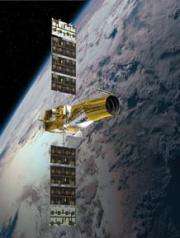The COROT satellite
(PhysOrg.com) -- University of Exeter, UK, research has added to a growing evidence that several giant planets have orbits so tilted that their orbits can be perpendicular or even backwards relative to their parent star’s rotation.
Known as ‘extrasolar planets’, because they are located outside our solar system, these planets orbit very closely to their star.
Planets are formed from a swirling disk of gas and dust that surrounds young stars. Because the disk rotates in the same direction as the star, the planets spawned by the disk should revolve in the same direction. In an overcrowded planetary system, however, planets can push one body outward while flinging the other inward, elongating and tilting the inner planet’s orbit.
Published as a letter to the Monthly Notices of the Royal Astronomical Society, the research involved examining the orbit of the first extrasolar planet discovered by the European satellite COROT. Known as COROT-Exo-1b, the planet can periodically be seen from Earth by telescope, as it passes across the face of its star. The research team observed the spectra of the star with the Keck telescope in Hawaii and discovered that its orbital axis was tilted at an angle of around 77 degrees.
The University of Exeter had already participated in the detection of two of these tilted planets in the past year, including the first know case, a planet known as “XO-3b”.
Since then astronomers worldwide have added their observations of tilted planets, making this one of the most talked-about phenomena of the year in astronomy. Currently between 25 and 50 percent of all extrasolar planets whose angles of inclination have been measured have tilts exceeding 30 degrees. Of the planets in the solar system, Earth has the greatest orbital tilt relative to the sun’s axis of rotation, at an angle of 7.1 degrees.
Frédéric Pont of the University of Exeter's School of Engineering, Mathematics and Physical Sciences, said: “The presence of advanced life on Earth may be contingent on our planetary system having avoided the brunt of planet-planet scatter, keeping Earth on a circular orbit—neither too hot nor too cold for life as we know it. In this scenario, the solar system may have been unusually lucky. Either it avoided catastrophic gravitational encounters between massive planets or it suffered such interactions so long ago that most of the planets had the chance to resettle into nearly circular orbits with little or no tilt.”
Provided by University of Exeter






















